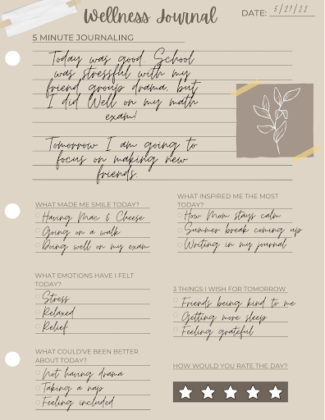 Grammar, the solar system, handwriting, and dinosaurs are examples of topics that are taught to children in schools, all of which will be used by the students as they learn, grow, and mature. What is not taught as often, though, are lessons on practicing emotional regulation, especially once students have entered their teen years. This may include ideas of incorporating alone time into their daily routines, asking for help in figuring out their thoughts or emotions, or sorting out their problems in a healthy manner. Emotion regulation is a key component to maturing as a human who is capable of functioning within small communities, or on a larger scale, society as a whole.
Grammar, the solar system, handwriting, and dinosaurs are examples of topics that are taught to children in schools, all of which will be used by the students as they learn, grow, and mature. What is not taught as often, though, are lessons on practicing emotional regulation, especially once students have entered their teen years. This may include ideas of incorporating alone time into their daily routines, asking for help in figuring out their thoughts or emotions, or sorting out their problems in a healthy manner. Emotion regulation is a key component to maturing as a human who is capable of functioning within small communities, or on a larger scale, society as a whole.
Teenage years can be very difficult to navigate as a parent — wanting to avoid awkward situations or overstepping, and in general treading carefully. This can lead to avoidance of addressing concerns or issues, on both the sides of the teenager and the parent. Mental health struggles are very prominent during teenage years, as their mind and body are going through several changes physically, personally, socially, and emotionally. Teenagers are stuck trying to form and adjust to their new identity, an identity that will bring new interests, experiences, and unfortunately hardships.
With these identity adjustments, an assortment of intense feelings will come to the surface, causing behaviors of feeling awkward, finding fault with their parents, being overconfident, acting out, or having poor self-esteem. Although there is no straightforward fix to helping your teen navigate this sensitive and crucial time in their development, there are simple methods, such as beginning a wellness journey, that could help make being a teen just a tad bit easier.
Wellness is defined in countless ways, the psychological definition including aspects of excelling in physical, social, and mental well-being. These categories can be narrowed down to specific categories of well-being dependent on each individual’s distinctive characteristics, examples being personal growth, spiritual being, or community involvement.
Wellness journeys can involve diverse paths of improving mental health, and can be tailored to how the individual feels about their emotions. Journaling is a wonderful way to express emotions, especially if the individual is more guarded or private regarding their personal lives.
Wellness journals can be a perfect addition to anyone’s mindfulness journey, but can be especially helpful for teens who decline to open up to others about their emotions or struggles. By creating a wellness journal, teens are able to release the positive, the negative, and the in-between emotions they may be feeling, with the help of daily prompts. Some of these prompts may include, but are not limited to, “what am I grateful for today?”, or “what would’ve made today better?”, and the best part is, teens can choose these prompts for themselves! An example wellness journal is shown below, although it can look however your teen wants it to!
By beginning a wellness journal, teens are given the freedom to express their emotions privately, but in a safe and healthy way. When expressing their emotions they are reminded of the gratitude they hold for themselves and their lives, which allows them to walk away from their entry feeling more at ease. Teens are constantly feeling an overwhelming and fast-paced flow of emotions, and sometimes they can become overwhelmed with handling several emotions at once. Keeping track of their high’s and low’s allow teens to look back and reflect on how far they’ve come, what they still wish to work on, and what they have achieved.
To get your teen started on their own wellness journal, simply purchase an empty journal (if your teen wants to create their own prompts), or purchase a template-filled journal below!




